Southern Trees (With Pictures) – Identification Guide
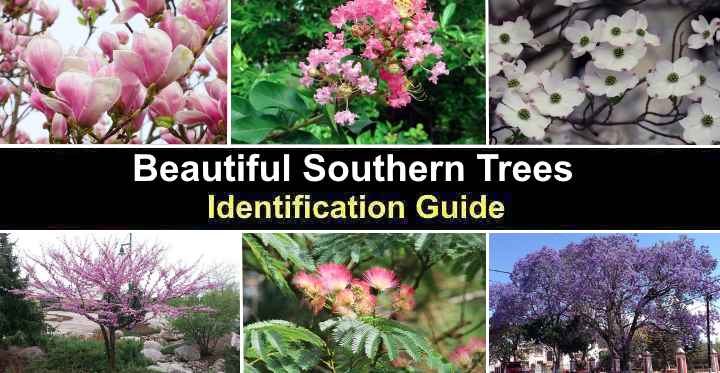
Southern trees are a beautiful addition to garden landscapes in the southern region of the United States. They tolerate the hot and humid climates of states such as Texas, Alabama, Georgia, Louisiana, Florida, and the Carolinas. Southern trees provide shade, color, and texture to your yard.
This guide explores ideal trees for southern gardens. It showcases descriptions and pictures of trees thriving in the heat and humidity of the southern United States.
What Are Trees for Southern Gardens
Trees in southern gardens offer shade, beauty, and wildlife habitats. They must withstand heat, humidity, and occasional hurricanes in Florida, Kentucky, Texas, Tennessee, and Arkansas.
Some great trees for Southern gardens include magnolias, crape myrtles, redbuds, and dogwoods.
How to Choose Trees for Garden Landscapes in the South
Careful consideration is key when selecting trees for Southern garden landscapes. Factors such as climate, soil conditions, and USDA growing zones in your southern garden are important. Additionally, tree size, growth rate, and shade preferences should be taken into account.
The growing zones for the South are typically as follows:
- Upper South — USDA Zone 6
- Middle South — Zone 7
- Lower South — Zone 8
- Coastal South — Zone 9
- Tropical South — Zones 10 and 11
Southern Trees — With Pictures and Descriptions
Here are some of the best and most stunning trees suitable for growing in southern landscapes.
Southern Magnolia (Magnolia grandiflora)
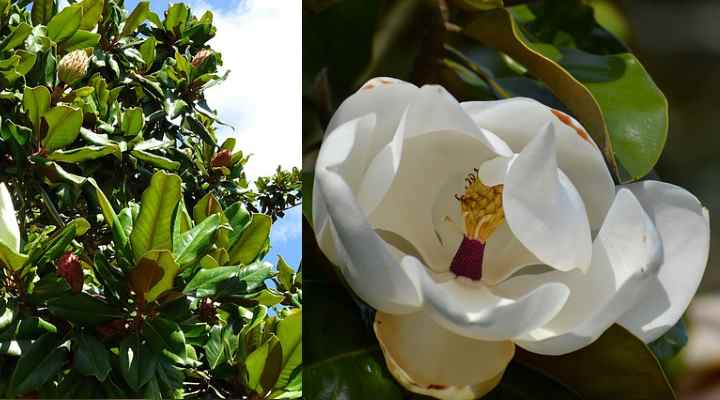
Southern magnolia is an attractive white flowering tree for southern USA
The Southern magnolia is a majestic evergreen tree for southern gardens. It features large, fragrant, creamy white cup-shaped flowers. Blooming in late spring and early summer, the tree’s showy white blooms are followed by large, cone-shaped fruits containing bright red seeds. These stunning ornamental trees can grow 60 to 80 feet (18 – 24 m) tall.
Southern magnolia trees are excellent shade trees for large landscapes in USDA zones 7 to 10. The tree’s glossy, dark green leaves and fragrant white flowers make it a popular ornamental tree throughout the southeastern United States.
Related reading: How to care for magnolia trees.
Saucer Magnolia (Magnolia × soulangeana)

Saucer magnolia is a southern tree with large flowers that come in shades of pink, purple and white
The saucer magnolia is a popular ornamental tree for southern landscapes. The sun-loving deciduous tree blooms in spring with stunning pink and white blossoms. The large goblet-shaped fragrant flowers measure up to 10” (25 cm) across and bloom before the tree’s leaves appear. It’s an ideal shade tree with dense, glossy green foliage that turns yellow in the fall.
Also called tulip magnolia, the small flowering tree grows 20 to 35 ft. (6 – 7.5 m) tall and up to 25 ft. (7.5 m) wide. The beautiful tree creates a stunning floral display of early spring flowers. It’s suitable for planting in USDA zones 4 through 9.
Sweet Bay Magnolia (Magnolia virginiana)
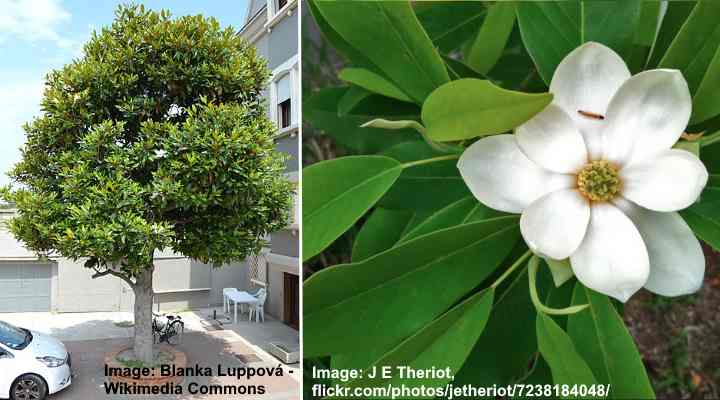
Sweet bay magnolia has scented white cup-shaped flowers and is evergreen in the most southern states
Sweet bay magnolia is a sun-loving southern tree that produces lemon-scented white flowers and glossy green leaves. Ideal for southern landscapes, the stunning ornamental tree is deciduous in the Upper South and evergreen in states around the Gulf of Mexico. Its fragrant cup-shaped flowers bloom from late spring through summer and attract native pollinators.
Sweet bay magnolia thrives in full sun or partial shade and moist, well-drained soil. Evergreen in southern climates, the multi-stemmed tree grows 10 to 35 ft. (3 – 10.5 m) tall and wide. In addition to its ornamental value as a decorative tree, sweet bay magnolia can grow as a large flowering shrub.
Related reading: Magnolia trees for Florida.
Crape Myrtle (Lagerstroemia)
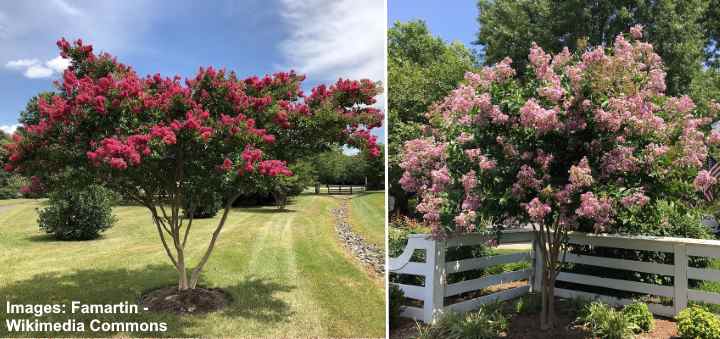
Crape myrtles are small flowering trees that grow best in full sun and are suitable for compact spaces
Crape myrtle, also known as the lilac of the south, is a popular small tree in sunny southern yards. The highlight of the southern tree is its masses of colorful flowers with crinkled petals in shades of white, pink, red, and purple. Crape myrtle’s striking flower clusters bloom in summer and fall, filling southern gardens with color and floral aromas.
Crape myrtle trees grow 6 to 25 ft. (1.8 – 7.6 m) tall, depending on the variety. They are ideal for planting as a specimen tree, as part of a mixed border, or as a hedge. Crape myrtles are suitable for growing throughout the South in USDA zones 7 through 9.
Flowering Dogwood (Cornus florida)
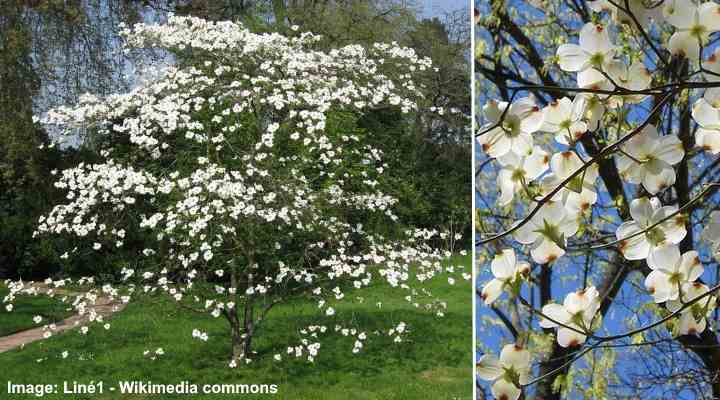
Dogwood is a flowering ornamental southern tree with attractive white flowers
Flowering dogwood is a popular ornamental tree in Florida, Texas, Kansas, and Arkansas. The small deciduous tree blooms in spring with masses of showy pink or white star-shaped flowers. In summer, orange-red berries cover the dogwood tree, and the foliage turns bright red or shades of purple in the fall.
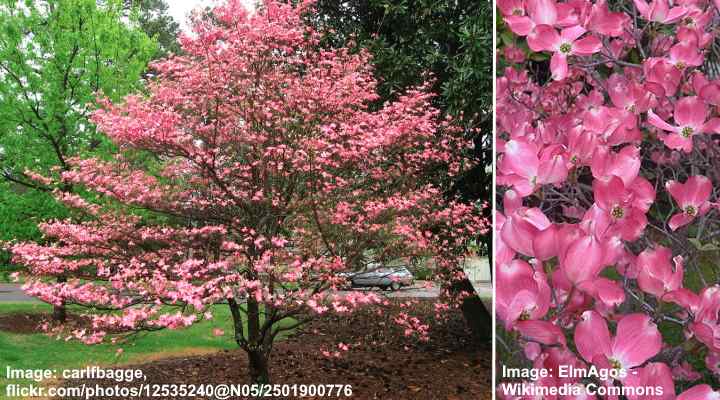
Pink flowering dogwood (Cornus florida ‘Rubra’)
Flowering dogwood thrives in full sun to partial shade and prefers moist soils with excellent drainage. In the South, the ornamental tree performs well as a specimen tree, shrub border, or lawn tree. It grows 15 to 30 ft. (4.5 – 9 m) tall and wide. It’s suitable for planting in USDA zones 5 to 9.
Eastern Redbud (Cercis canadensis)
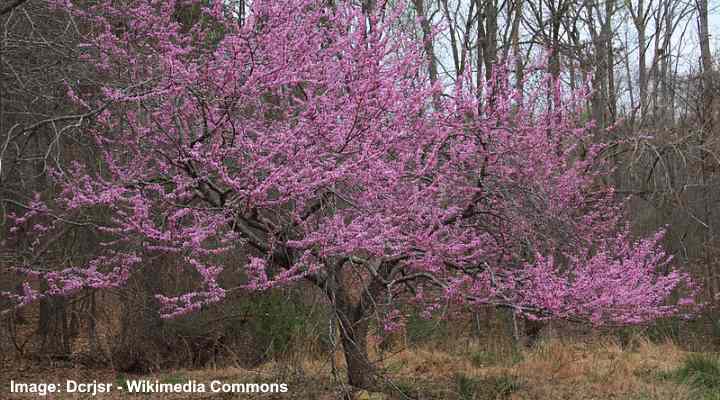
The pink flowering eastern redbud tree looks beautiful in small or large gardens in southern USA
Eastern redbud is a small, deciduous early spring-blooming tree with pink or purple pea-like flower clusters on bare branches. Blue-green heart-shaped leaves emerge after the flowers, turning yellow in the fall. Long, bean-like seed pods grace the tree in the fall as they dangle from branches.
Eastern redbuds grow 20 to 30 ft. (6 – 9 m) tall and wide, making them ideal ornamental trees for small yards through the southern states. In addition to its spectacular pink flowers, the tree has an irregular branching habit, making it attractive in winter.
Oklahoma redbud (Cercis canadensis var. texensis ‘Oklahoma’) is the state tree of Oklahoma. It grows 12 to 18 ft. (3.6 – 5.5 m) tall and up to 20 ft. (6 m) wide. The native flowering tree is suitable for planting in USDA zones 4 through 9.
Silk Tree (Albizia julibrissin)
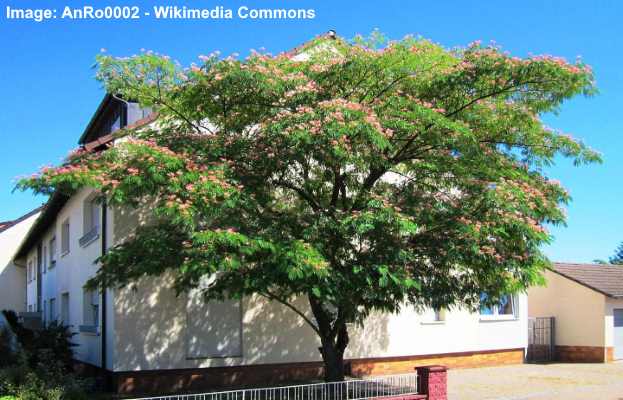
Mimosa tree is low-maintenance and fast grower southern tree with stunning fuzzy pink flowers
The silk tree, or mimosa Persian silk tree, is a deciduous southern tree. It has eye-catching foliage and powder-puff pink flowers. The tree’s fern-like leaves and large, fluffy, pink fragrant blooms appear in late spring and early summer. After flowering, large 7” (17 cm) long seed pods appear and persist through winter.
Silk trees grow 20 to 40 ft. (6 – 12 m) tall and up to 50 ft. (15 m) wide. The beautiful shade trees are ideal for planting in southern landscapes. The fast-growing tree withstands humidity and high summer heat. They are suitable for planting in USDA zones 6 through 9.
Japanese Flowering Cherry Tree (Prunus serrulata)
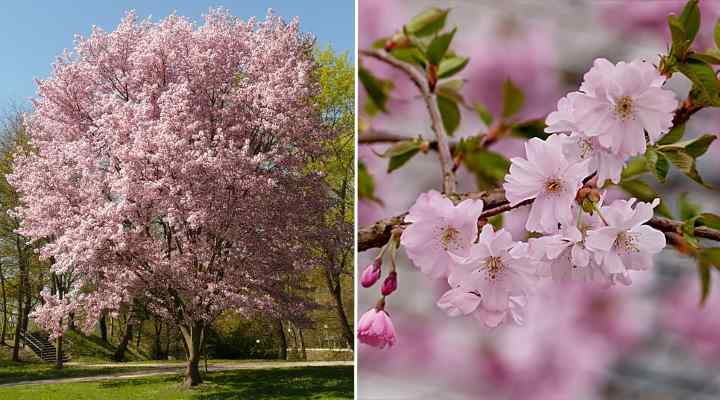
The Japanese flowering cherry tree is a focal point in any southern landscape
The Japanese flowering cherry tree is a stunning ornamental tree that fills spring gardens with beautiful pink and white blossoms. These cherry blossom trees thrive in sunny southern landscapes, tolerating summer heat, and reach a height and width of 15 to 25 ft. (4.5 – 7.6 m).
The cherry blossoms can measure up to 1” (2.5 cm) across, and the delicate petals and leaves create a stunning shade canopy. Leaves emerge reddish-brown, turning green before turning yellow, red, and bronze shades in the fall. Hardy to Zone 9, the cherry blossom trees thrive throughout the South.
Jacaranda (Jacaranda mimosifoila)
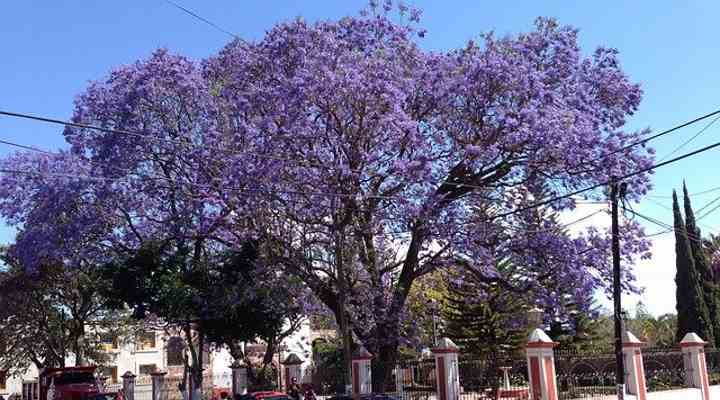
Jacaranda tree has beautiful purple flowers and can be grown in the southernmost parts of USA
Jacaranda is a stunning purple-flowering tree common in southern landscapes. Also called the fern tree, the stunning southern tree is covered in clusters of fragrant, trumpet-shaped purple-blue flowers in early summer. The tree’s fern-like leaves are bright green and are semi-evergreen in southern states.
Jacaranda trees grow up to 50 ft. (15 m) tall and 30 ft. (9 m) wide. The tree’s attractive spreading vase shape makes it an ideal shade tree for southern landscapes, parks, and gardens.
The purple-flowering, drought-tolerant jacaranda trees are ideal for USDA zones 10 and 11 growing in moderately fertile, well-drained soil.
Downy Serviceberry Tree (Amelanchier arborea)
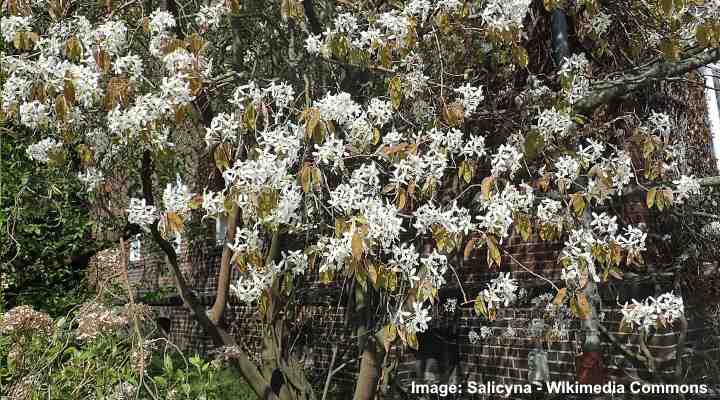
The small downy serviceberry tree is a great addition to compact southern yards
Downy serviceberry is a small, deciduous tree perfect for sunny yards in Central Florida, Louisiana, Texas, and Alabama. The tree’s ornamental features are its clusters of white, fragrant spring flowers followed by small, edible purplish-black berries. The leaves turn a beautiful reddish-orange in the fall, adding to the tree’s ornamental value.
The downy serviceberry tree grows 15 to 25 ft. (4 – 7.6 m) tall and wide. Throughout the deep South, serviceberry trees are ideal as specimen trees, natural screens, or planting along shrub borders. Its tolerance for soggy ground makes it perfect for planting alongside streams or ponds in USDA zones 4 through 9.
Fringe Tree (Chionanthus virginicus)

The small fringe tree, a deciduous species, displays white scented flowers and thrives in sunny southern landscapes.
The fringe tree is a stunning ornamental tree perfect for sunny southern landscapes. Blooming in late spring or early summer, this small deciduous tree is known for its fragrant, white, spindly flowers. The delicate, feathery flower clusters cover the entire tree, creating a stunning floral display. The tree’s attractive, dark green lanceolate leaves turn golden-yellow in the fall.
The fringe tree grows 12 to 20 ft. (3.6 – 6 m) tall and wide. Thriving in the southern sunshine, the tree is perfect for a lawn tree, specimen plant, or decorating mixed borders. It’s also easy to maintain and requires minimal pruning.
The fringe tree is suitable for growing in USDA zones 3 to 9.
Common Hawthorn (Crataegus monogyna)
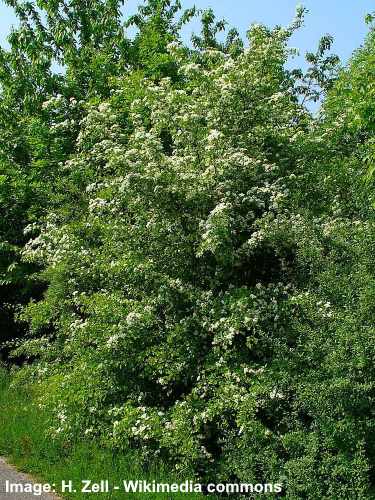
The common hawthorn tree can be grown in upper and middle southern USA
The common hawthorn tree is a sun-loving deciduous tree suitable for the northern ranges of the southern states. The thorny tree produces clusters of creamy-white flowers and glossy green, lobed leaves on thorny branches. The showy flowers are followed by small red or black fruits. Hawthorn trees grow 30 ft. (4.5 – 9 m) tall and wide.
Hawthorn trees are ideal for planting in sunny southern landscapes. Low maintenance and fast growth make them excellent specimen trees or hedge plants. The tree’s dense growth habit and spiny branches provide a natural barrier for privacy and wind protection.
Hawthorn trees are suitable for growing in USDA zones 5 through 7.
Tulip Poplar (Liriodendron tulipifera)
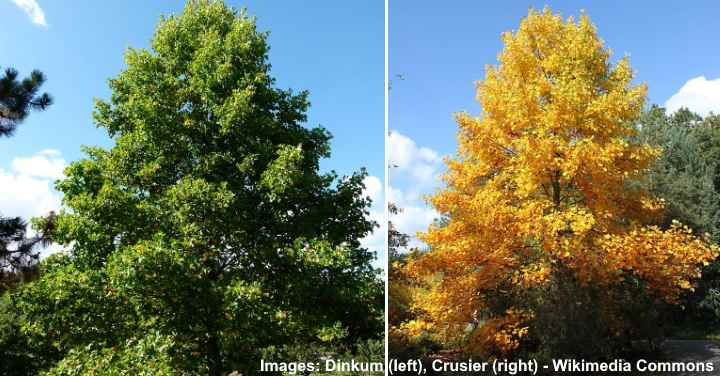
Tulip poplar trees – summer and autumn foliage
The tulip poplar is a fast-growing deciduous tree with spectacular yellow or orange tulip-like flowers. Its bloom time is spring and summer when the tulip tree transforms southern landscapes with showy floral displays, dense foliage, and striking fall colors. The large yellow-green or orange flowers measure 3” (7.5 cm).
Tulip poplar trees grow 60 to 80 ft. (18 – 24 m) tall and 30 to 40 ft. (9 – 12 m) wide. The tulip tree is an excellent choice if you are looking for a stunning shade tree for a southern landscape.
Tulip poplar trees are suitable for planting in USDA zones 4 through 9. It is the state tree of Indiana, Tennessee, and Kentucky.
Texas Mountain Laurel (Sophora secundiflora)
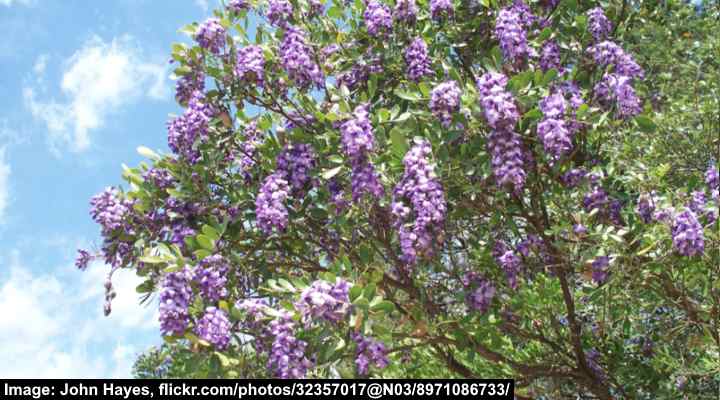
The Texas mountain laurel is a purple flowering tree native to Texas that is suitable for full sun or partial shade
Texas mountain laurel is a sun-loving evergreen shrub-like tree with a narrow, upright habit. The ornamental tree blooms in spring with dangling clusters of beautiful purple-blue flowers like fragrant wisteria flowers. The aroma of the purple flowers resembles grape soda. These contrast nicely with the glossy dark green leaves.
Texas mountain laurel grows up to 15 to 25 ft. (4.5 – 7.6 m) tall and 10 ft. (3 m) wide. The drought-tolerant tree thrives in full sun and well-draining soil. Its tolerance to drought makes it the perfect choice for landscaping xeriscape gardens, as a privacy screen, or a shade tree in a southern backyard.
Golden Rain Tree (Koelreuteria paniculata)
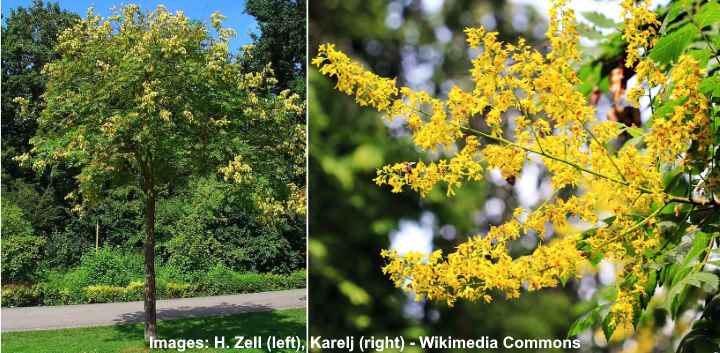
The golden rain tree is a small to medium yellow flowering tree that adds pop of color to southern gardens
The golden rain tree is a small to medium-sized deciduous tree that adds a splash of color to any southern landscape. The tree produces large 12” (30 cm) long cylindrical clusters of yellow flowers throughout the summer. These are followed by masses of greenish-yellow seed pods that look like papery lanterns.
In the fall, the golden rain tree’s foliage turns a rusty brown. It is ideal for summer shade in the South. The tree grows 30 to 40 ft. (9 – 12 m) tall and wide, with an open branching habit and rounded canopy. The ornamental tree is an excellent specimen plant, shade tree, or street tree.
Golden rain trees are suitable for growing in USDA zones 5 to 9.
Southern Crabapple (Malus angustifolia)
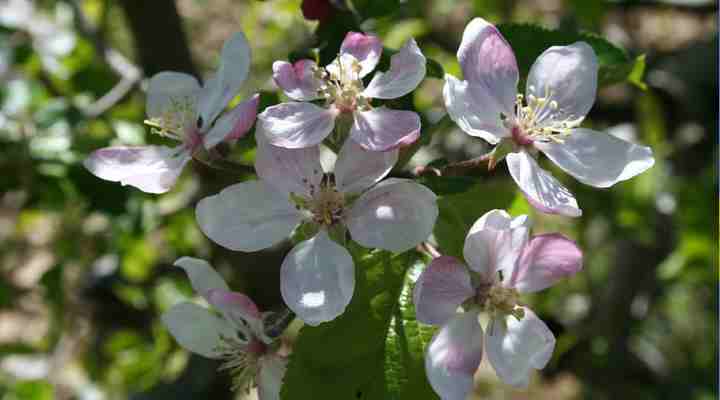
Southern crabapple is an ornamental tree native to southeastern USA with attractive pinkish-white flowers
Southern crabapple is a small, deciduous tree native to the southeastern United States. The tree produces fragrant, pink, or white blossoms in the spring and small, edible crabapples in the fall. The tree can grow up to 25 ft. (7.6 m) tall and wide and prefers full sun to partial shade.
Southern crabapple is an excellent addition to a Florida, Texas, Kentucky, and Illinois garden landscape. Its spreading branching habit has tremendous ornamental value. Additionally, its tiny crabapples are a source of food for wildlife. Southern crabapple trees grow 30 ft. (9 m) tall.
Southern crabapple is suitable for growing in USDA zones 6 to 9.
Royal Poinciana (Delonix regia)
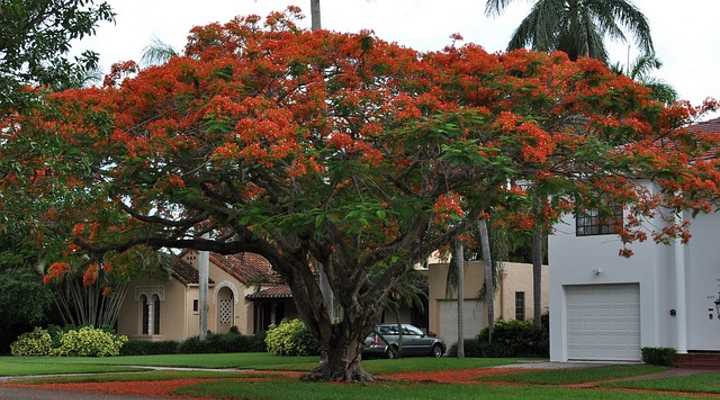
Royal poinciana tree is suitable for growing in the tropical parts of southern USA
Royal poinciana is one of southern Texas or Florida’s most stunning tropical trees. The medium sized tree has a broad, spreading, umbrella-like canopy covered in vibrant red-orange flowers. The large, showy flowers bloom in late spring or early summer and contrast nicely with feathery, fern-like leaves. In the fall, large dangling seed pods decorate the shade tree.
Also called the flamboyant tree, royal poinciana grows 30 to 40 ft. (9 – 12 m) tall and up to 70 ft. (21 m) wide. Ideal for USDA zones 10 to 12, you can plant the flamboyant tree as a lawn tree or provide shade for a patio or seating area.
Trumpet tree (Tabebuia aurea)
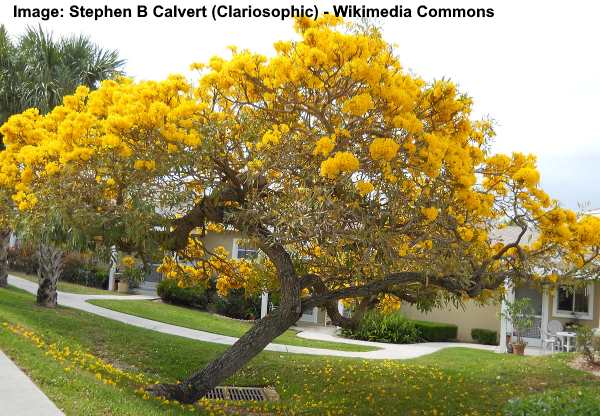
The yellow flowering trumpet tree adds vibrant color to tropical southern landscapes
The trumpet tree, also known as the tree of gold, is a stunning tropical tree that creates a dramatic burst of color with a profusion of trumpet-shaped yellow flowers. The bright yellow funnel flowers grow in clusters and measure 3” (7.5 cm) long. It’s an ideal shade tree for southern gardens due to its vase-shaped, spreading canopy.
The trumpet tree grows up to 40 ft. (12 m) tall and has a spreading canopy. The bright yellow flowers mean the trumpet tree is an ideal ornamental tree for sunny landscapes. Once established, it’s drought-tolerant and thrives in the hot conditions of southern Texas, Louisiana, and Florida.
The trumpet tree is suitable for growing in USDA zones 10 to 11.
Jerusalem Thorn (Parkinsonia aculeata)
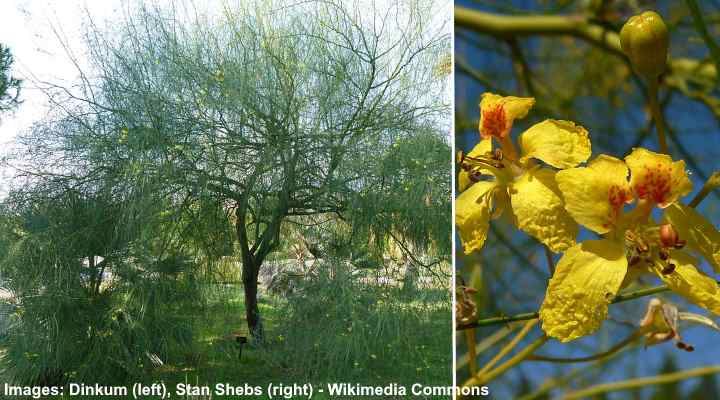
Jerusalem thorn is a fast growing and low maintenance southern tree with yellow flowers
Jerusalem thorn is a sun-loving shade tree, perfect for warm, dry climates of the southern states. Ornamental features of this fast-growing tree are its small, bright yellow flowers that bloom profusely throughout spring, summer, and early fall. The Jerusalem thorn tree also has smooth green bark, thorny branches, and 5” (13 cm) long bean-like seed pods.
Jerusalem thorn is a low-maintenance tree that thrives in full sun and well-drained soil. In USDA zones 8 to 11, it grows 15 to 20 ft. (4.5 – 6 m) tall. Tolerant of drought and intense heat, the tree is an excellent choice for a specimen tree, shade tree, or windbreak.
Silver Wattle (Acacia dealbata)
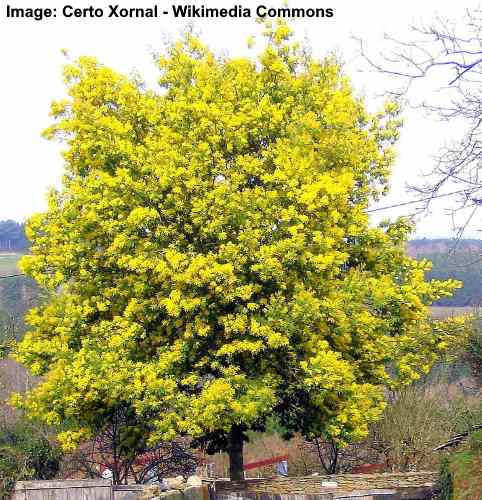
Silver wattle is a yellow flowering tree suitable for warmer zones in southern USA
Silver wattle is a medium sized, fast-growing evergreen tree that thrives in the full sunshine and heat of southern states. Also called the blue wattle, the tree has delicate, silvery-gray feathery leaves and clusters of fluffy yellow fragrant flowers that bloom in late winter and early spring. The yellow-flowering tree grows 40 to 50 ft. (12 – 15 m) tall and wide.
Silver wattle is ideal for planting in sunny landscapes as an accent tree or windbreak. It’s suitable for growing in USDA zones 9 through 11. To care for the tree, ensure the soil is well-draining soil and water it regularly during the growing season.
Related articles:
